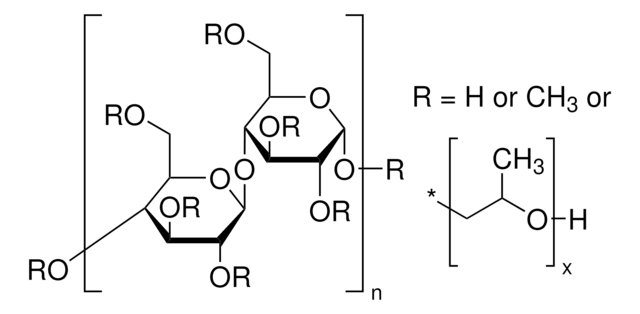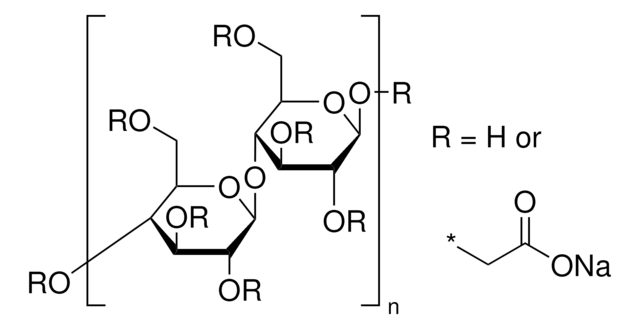191906
Hydroxypropyl cellulose
average Mw ~1,000,000, powder, 20 mesh particle size (99% through)
About This Item
Produtos recomendados
descrição
biological oxygen demand (BOD) 14,000 ppm
Nível de qualidade
forma
powder
temperatura de autoignição
752 °F
peso molecular
average Mw ~1,000,000
Impurezas
<5 wt. %
tamanho de partícula
20 mesh (99% through)
pH
5.0-8.5
tensão interfacial do óleo mineral
12.5 dyn/cm, 0.1 wt. % in H2O (vs. mineral oil)
viscosidade
1,275-3,500 cP, 1 wt. % in H2O(25 °C, Brookfield, spindle #3) (30 rpm)(lit.)
solubilidade
H2O: insoluble (above 45 °C)
polar organic solvents: soluble
densidade
0.5 g/mL at 25 °C (lit.)
InChI
1S/C12H20N2/c1-5-12(13)11-7-6-10(14(3)4)8-9(11)2/h6-8,12H,5,13H2,1-4H3
chave InChI
RRHXDYJWVYFMKV-UHFFFAOYSA-N
Procurando produtos similares? Visita Guia de comparação de produtos
Categorias relacionadas
Aplicação
- Thermo-responsive aqueous foams: Hydroxypropyl cellulose has been studied for its properties as a green polymer that can alter its solubility with temperature changes, making it suitable for responsive foam applications (Braunschweig, 2019).
- Interaction mechanism in aqueous solutions: A study on the interaction between hydroxypropyl cellulose and water in solutions, focusing on the importance of polymer chain length in determining the physical properties of the solutions (Martin-Pastor and Stoyanov, 2020).
- Corrosion inhibition: Hydroxypropyl cellulose has shown effectiveness as a corrosion inhibitor for aluminium in acidic environments, highlighting its potential in material science and engineering applications (Nwanonenyi et al., 2019).
- Orally disintegrating films: This application involves the formulation design of hydroxypropyl cellulose films, aiming to enhance the delivery and dissolution profile of pharmaceuticals, making it significant in drug delivery and pharmaceutical sciences (Takeuchi et al., 2018).
Código de classe de armazenamento
11 - Combustible Solids
Classe de risco de água (WGK)
WGK 1
Ponto de fulgor (°F)
Not applicable
Ponto de fulgor (°C)
Not applicable
Equipamento de proteção individual
Eyeshields, Gloves, type N95 (US)
Escolha uma das versões mais recentes:
Já possui este produto?
Encontre a documentação dos produtos que você adquiriu recentemente na biblioteca de documentos.
Os clientes também visualizaram
Nossa equipe de cientistas tem experiência em todas as áreas de pesquisa, incluindo Life Sciences, ciência de materiais, síntese química, cromatografia, química analítica e muitas outras.
Entre em contato com a assistência técnica


